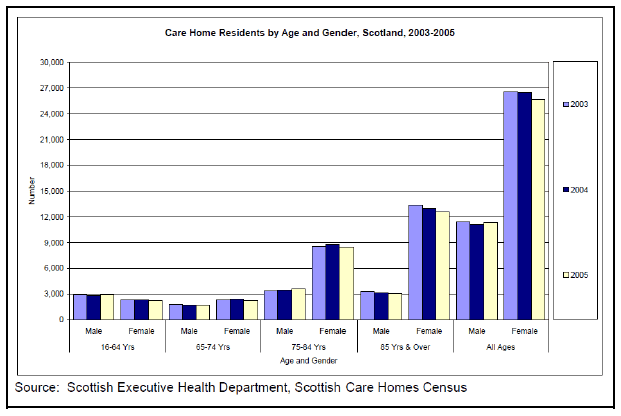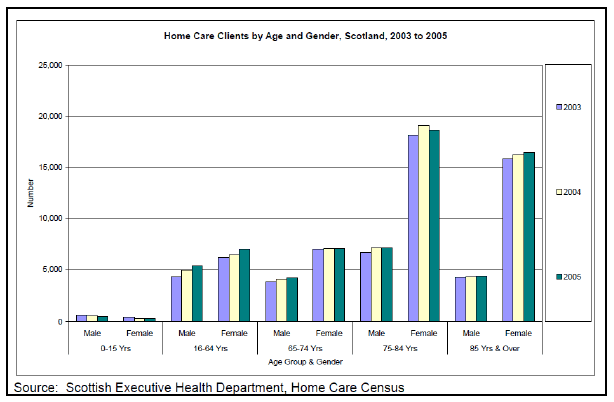Scottish Government Equality Outcomes: Age Evidence Review
This evidence review was prepared to support the production of the Scottish Government's Equality Outcomes, with regard to age.
12 Social care
12.1 This section addresses care of older people, help with daily living, childcare, and the provision of informal care.
Formal care
12.2 In 2011 the vast majority of both home-care clients (82%) and long stay care home residents (86%) were at least 65 years old[151]. The High-level summary of equality statistics[152] plots the care home population by age and gender (see Figure 15). Over the period 2003 to 2005 the number of older people (aged 65 years or over) in care homes, which make up 86% of the care home population, fell by almost 900 from the 2003 level of around 33,000. This drop can mainly be attributed to a drop in the numbers of residents aged 85 years and over in care homes with almost 1,000 fewer in 2005 than in 2003.
Figure 15: Care home residents by age and gender

12.3 In contrast to the reduction in care home residents, the number of people being cared for in their own homes has risen over the same period[153] (see Figure 16). Between 2003 and 2005 there was an increase in the number of home care clients in each age group with the exception of the 0 to 15 year age group in which there was a small drop. In 2005, roughly 58,000 home care clients were aged 65 or over, this was an increase of over 2,000 from the 2003 level of around 56,000. The biggest increase occurred in the 16 to 64 year age group with over 1,000 more males and 800 more females in this age group in 2005 than in 2003. There were also increases of over 900 and 750 in the 75 to 84 years and 85 years and over age groups. In 2005, females made up 70% of all home care clients, due mainly to larger numbers of women aged 75 years and over.
Figure 16: Home care clients by age and gender

12.4 In terms of the experiences of older people, one key area of concern to the EHRC in its Triennial Review is the use of restraint. In 2007 a report, Rights, risks and restraints[154] from the Commission for Social Care Inspection, gave many examples of restraint undermining the wellbeing and dignity of vulnerable older people. The Commission used qualitative methods primarily and says it cannot, from this work, give an idea of the prevalence of restraint.
Informal care
12.5 The EHRC Triennial Review finds that men and women are more likely to report needing help with Activities of Daily Living and Instrumental Activities of Daily Living and receiving more help as they get older. Older people are more likely to report receiving help which meets their needs than younger people. Initial analysis of the English Longitudinal Survey of Ageing 2004[155] conducted as part of the development of the Equality Measurement Framework, shows that 57% of those aged over 75 felt this was the case, compared with 40% of those aged 65-74 and 37% of those aged 50-64. Sources of help and support differ by gender and age. Except for women aged 75 years and over, a spouse or partner was the most common source of help. Married men also receive most of their support from their spouses regardless of their age. Many of those women aged 75 and over were widowed - for these women children were a prominent source of help, particularly for those aged 85 and over. For men aged over 85, many received help and support with shopping and working in the house and garden from friends and neighbours.
Childcare
12.6 Younger mothers appear to be more likely to use informal childcare than parents overall. The Youth Cohort Study 2008[158] (England) found that by age 17, 3% of respondents had children of their own. The majority of these respondents (88%) had their children living in the same household as them, and just over two-fifths (41%) had a partner living with them. The survey found that these mothers were most likely to use informal care (as opposed to any other providers). The mother's parents were the most likely to provide care for this group with 37% of young mothers stating this as one of the types of childcare they used, followed by 18% using another relative and 10% using the ex-partner or the child's non-resident parent. Attending a playgroup or pre-school or using a childminder were the least commonly used options for childcare (4% each).
Carers
12.7 According to the 2001 Census, people in their fifties are more likely than people in any other age group to provide care[157]. More than 1 in 5 people aged 50-59 are providing some unpaid care. The provision of informal care in later life is associated with socio-economic status: people aged 55-69 from lower occupational groups are more likely to be caring for a spouse than those from higher ones. This is linked both to a higher incidence of disability among those in lower occupational groups, and to the inaccessibility of support for those without the resources to pay for it. Many older people play an important role in caring for their grandchildren. In Scotland and Wales, grandparents are the most common source of childcare; in England, they are the most common source of informal childcare and make up 26% of all childcare used.
Contact
Email: Social Research
There is a problem
Thanks for your feedback